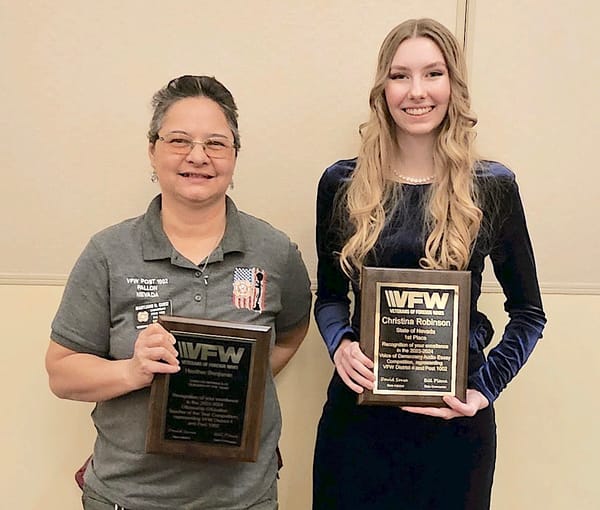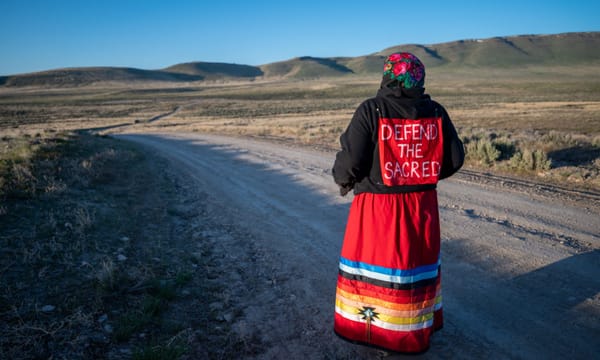Spring Mountains National Recreation Area—More than a backyard

Submitted by U.S. Forest Service
LAS VEGAS – It happens throughout the year, an influx of visitors excited to throw off the trappings of the city head to the mountains for fun in the great outdoors. While national forests are wonderful places to recreate and enjoy nature, the pleasure of using these spaces comes with responsibilities shared by all who visit.
People Are Not the Only Ones Here
The Spring Mountains National Recreation Area, or Mount Charleston as it is known by locals, is one of 19 National Recreation Areas in the United States and was established by the U.S. Congress in 1993. With elevation ranges from 3,000 feet to just under 12,000 feet in elevation, the area is home to seven ecological zones and at least 25 different species of plants, animals and insects found nowhere else in the world. This unique landscape is just northwest of Las Vegas and serves as a natural escape for one million city-dwellers annually.
“Part of the fun of the outdoors is exploring the beauty of it,” said Katy Gulley, Wildlife Ecologist for the Spring Mountains National Recreation Area. “What people may not realize is just how fragile and interconnected that beauty is.”
“The plants, animals, and insects found on our forest are interconnected in complex ecosystems,” she continued. “While for the most part resilient, these ecosystems can only accommodate a certain amount of use by humans.”
Gulley said it is because of this interconnection that it is important to reduce impacts when visiting the mountain, regardless the time of year.
“Don’t pick flowers, so they can remain as nectar sources for our endemic pollinators,” she explained. “Eventually some of these flowers will turn in to seed and be used by other small mammals or birds. And when those seeds fall to the ground, they will be food for other insects, or grow into plants themselves. Everything here serves a great purpose and has evolved here as part of this great Spring Mountains ecosystem.”
“Staying on designated trails is another excellent way to limit impact on plants and wildlife,” added Gulley. Repeated off-trail trampling can injure or kill plants, leaving them to no longer be good sources of food or habitat for other species, she explained.
Overuse can adversely affect not only plant and animal life in the area, but the soil itself, especially when there is not enough snow to protect moist soils.
“The main issue is that the soil is generally wet, to the point of saturation, at the surface,” said James Hurja, Soil Scientist for the Humboldt-Toiyabe National Forest, referencing soil conditions during snow melt. “Moist or wet soils are highly susceptible to the loss of soil structure, resulting in soil compaction, displacement, puddling, and rutting.”
Hurja explained when there is a lot of snow, that snow insulates and helps protect the ground. However, when snow levels are low, a single run by a sled down a slope may not cause damage, but repeated use of that sled path by additional users will continue to remove any remaining snow, compressing the mud under the sled.
“Compacted soils and ruts can result in increased erosion, losing valuable topsoil necessary for plant growth and seedling establishment,” said Hurja.
Overuse does not just occur in the winter with desert-dwellers excited to frolic in a dusting of snow on the mountain. Jonathan Stein, Developed Recreation Director for the Spring Mountains National Recreation Area, said the repeated crushing of meadow plants during other seasons causes challenges too, especially when the intense rains of the summer arrive.
“We still get a ton of trampling of the grasses and plants from year-round use,” Stein added. “The trampling causes our flood and erosion events to be more extreme when we get monsoon rains.”
Loving the Mountain Too Much at Once
It is easy to understand why people would want to recreate in the unique environment the Spring Mountains National Recreation Area provides. Just 25 miles outside of Las Vegas via paved roads, it is an area that is close to the city and easy to reach with the average passenger car.
Over the two weeks that spanned the Christmas and New Year’s holidays in 2019, hundreds of thousands of people visited the Mount Charleston area, in primarily Lee and Kyle Canyons. While these areas can support typical daily visitors, the roads cannot handle so many visitors all at once.
Challenges also crop up when infrastructure, like available designated parking spaces, are unable to absorb such volume. While parking areas can typically accommodate the amount of people who want to visit the mountain on any given weekend, there is simply not enough space in these narrow canyons to support the crush of holiday visitors.
“Parking violations continue to create hazards for the general public and emergency responders in the area during high-traffic days,” said Nicholas LaPrade, USDA Forest Service Law Enforcement Officer for the Humboldt-Toiyabe National Forest. “Some citations are for violating posted instructions and others are more blatant, such as parking in actual highways or blocking access to areas.”
“Sanitation is also an issue,” he continued. “Tons of trash is left behind for staff, volunteers and caring visitors to address.” While Forest Service law enforcement officers have issued warnings and citations for these types of violations, the challenge of getting visitors to pack out trash or place it in proper receptacles persists.
LaPrade added there are several rules visitors may not be aware of, especially when it comes to fire restrictions. “We find visitors violating the year-long fire restriction order,” he said, referencing an order that states campfires are not allowed within one mile of homes in Kyle Canyon, Lee Canyon, Cold Creek, Mountain Springs, Trout Canyon, Lovell Canyon, and Coal Springs.
Rules about controlled substances also cause confusion for visitors to federal lands in a state where adult personal use of cannabis is allowed in non-public places. “Possession of marijuana is still prohibited on National Forest System Lands in any amount,” explained LaPrade.
Outdoor Alternatives
Considering the novelty of snow in the desert, it is understandable visitors would want to venture the short distance from Las Vegas to experience the gifts provided by this forested island in the desert.
For those specifically interested in playing in snow, Lee Canyon Ski Resort typically makes snow during the winter months. Especially during high traffic times, Ski Resort visitors are reminded to keep a copy of passes or online reservations handy to show law enforcement officers monitoring traffic. Also, due to COVID restrictions, parking reservations are required at the resort.
However, for those simply wanting to enjoy the outdoors with family and friends, there are multiple options in less-crowded locations that are still easily reached by the average passenger car. With more than 300,000 acres comprising the Spring Mountains National Recreation Area, there are many areas visitors can enjoy that are not as highly trafficked as the majority of those located in Kyle and Lee Canyons.
“We have sites that are open with access to trails that might be too warm to visit during the summer,” said Stein, explaining why winter is a good time to take advantage of less-visited locales.
The Sawmill Trailhead off Nevada State Route 156 (Lee Canyon Road) provides picnic opportunities and bathrooms as well as more than 35 miles of trails for hikers and equestrians to explore, with mountain bike access to all but 13 miles of those trails.
The Cliff Rose Trailhead off the Nevada State Route 157 (Kyle Canyon Road) roundabout offers parking, bathrooms, and access to two separate three-mile loops open to mountain bikers, equestrians and hikers.
For those with high-clearance vehicles, the Bonanza Trailhead is accessible via the town of Cold Creek, Nevada, and offers access to more than 17 miles of equestrian, hiking, and biking trails. Likewise, there is a trailhead at the top of Lovell Canyon, which is just outside of the community of Mountain Springs, southwest of Las Vegas, that can be accessed with four-wheel drive vehicles. There are no facilities at this trailhead, so adventurous visitors should be prepared to pack out all trash and waste with them.
With Great Access Comes Great Responsibility
The mission of the Forest Service is to sustain the health, diversity, and productivity of the Nation’s forests and grasslands to meet the needs of present and future generations. While there are many who work diligently throughout the year to help accomplish this mission, it cannot be met solely by the organization and its nonprofit partners and volunteers. It is up to each individual who marvels at a mountaintop sunset, creates memories picnicking with family and friends, or simply exhales to the oceanic sound of breezes passing through evergreen trees, to help protect and preserve the areas that provide these experiences for generations to come.





